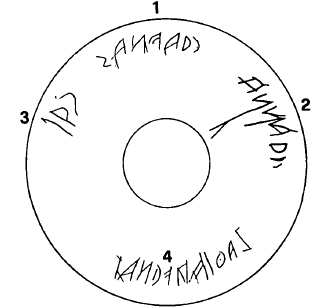No CrossRef data available.
Article contents
Etruscan graffiti on Oxford 213
Published online by Cambridge University Press: 23 December 2013
Extract
The very full recent publication of the Athenian black figure amphora, Ashmolean Museum 213, invites reflection on the graffiti beneath its foot which might offer information about the find place of the vase. It was formerly in the Castellani Collection and taken by Beazley as the name piece of his Painter of Oxford 213.

Of the four inscriptions (see Fig. 1) three are obviously interrelated: the most complete (1) reads cravnas; 2 is probably an incorrect version of the same name with a mistake over the first nu (cranna), while 3 has simply the first two letters cr followed by an incomplete a. Despite the hesitant script it is clear that the writer made three attempts to write the name and succeeded only with the last which is correctly written. The fact that in each case the rho is written in the reverse direction to the rest of the name shows that the three inscriptions are by one hand. This is the first evidence for the name cravnas. The suffix -s suggests Cravna as the owner of the object, this usage being normal for south Etruria. The variant cranna, intended for cra(v)nna (cra(u)nna), may be compared with the occasional doubling of nu met in seventh-century Cerveteri, perhaps a peculiarity of pronunciation.
- Type
- Notes
- Information
- Copyright
- Copyright © The Society for the Promotion of Hellenic Studies 1978
References
1 CVA Oxford iii, pls. 14; 15.1, 2.
2 Beazley, , ABV 340Google Scholar; Paralipomena 152.
3 Cf. Pallottino, M., Testimonia linguae etruscae 2 (1968)Google Scholar no. 58 (θannursiannas, mulvannice), no. 939 (turannuve, or rather turanuve).
4 *saθia as a possessive presupposes a name *saθi which in this context should be masculine (cf. ati: atia > atial; Cristofani, M., ArchClass xxv–xxvi [1973–1974] 154–5)Google Scholar.
5 Illustrations in Monlnst vi (1862) pl. 56. Most recently on the inscriptions, Vetter, E., Handbuch der italischen Dialekte (1953) 340eGoogle Scholar. For the association of Prenestine names with Etruscan see the gloss of Hesychius in Pallottino, op. cit. no. 815.
6 On this problem see Simone, C. de, Studi Etruschi xl (1972) 153Google Scholar ff. I can see no possibility of any close association with the Oscan cognomen Aukil (Aucilus) attested at Herculaneum (Vetter, op. cit. 90, no. 107) from which the Etruscan *auciina should be derived (cf. Lat. Rutilus, Etr. rutile, rutelna, etc., in Ampolo, C., Parola del Passato xxx [1975] 413Google Scholar ff.).
7 Cristofani, M., ArchClass xviii (1966) 103Google Scholar ff.
8 Cf. the discussion in Ľetrusco arcaico, Atti delľincontro di studi, Firenze, 1974 (1976) 146–9.
My thanks are due to John Boardman for the translation of this note.




